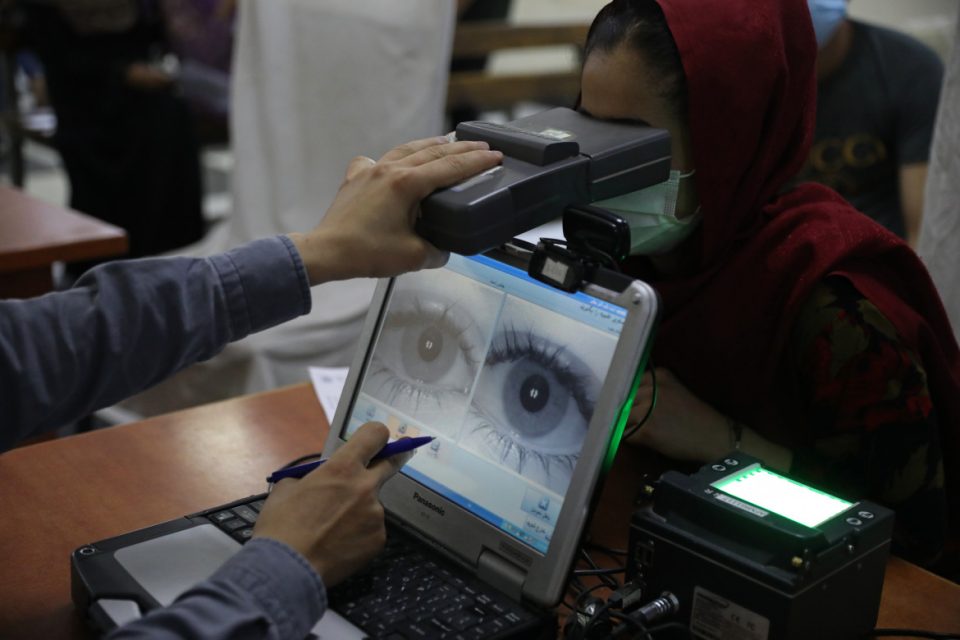The whole world watched as the Taliban celebrated the taking of Kabul, and the ruinous US retreat from the airport, by brandishing American weapons and wearing their uniforms aboard their armored vehicles. A stockpile of weapons left behind by the army is now in the hands of the extremists, and there is still no clear picture of the arms they control.
But what was also left behind was a non-lethal weapon even more powerful than missiles or drones: the devices and databases for collecting and cataloguing the biometric data of the population.
Names, surnames, jobs, family connections, ethnicity, fingerprints, iris scans—which, if the “détente strategy” announced by the Taliban proves to be nothing more than a façade, as it is fair to assume at this point—could lead them with little effort to the people who have collaborated with Western forces, or worked for the government.
Three days after the fall of Kabul, on August 18, U.S. military sources confirmed to The Intercept that during the offensive, the Taliban took possession of HIIDE (Handheld Interagency Identity Detection Equipment) devices, used by the American armed forces for military operations and connected to the ABIS database, maintained at the Department of Defense and used to identify the targets of drone attacks, as explained by investigative journalist Annie Jacobsen.
At first, its purpose was purely military: establishing U.S. “identity dominance” in the Central Asian country would give the U.S. a strategic advantage over the enemy: preventing attacks on the army and obtaining valuable intelligence on its plans and movements.
What soon became clear, however, was that HIIDE and the other devices used by the army are, in a sense, the least of the worries for Afghan citizens who were unable to board flights out of the country. Eileen Guo and Hikmat Noori, in their investigation published on August 30 for the MIT Technology Review, made it clear that the real danger is represented by the biometric databases that the U.S. has developed in collaboration with the Afghan government for civilian purposes: census, fighting fraud such as “phantom salaries” for non-existent members of the army and police, and managing democratic processes such as voting.
Unlike the database to which HIIDE has (limited) access, protected by the U.S. State Department, these are Afghan databases, maintained at the various ministries in Kabul, in all likelihood in the hands of those who now hold power.
The influence of the U.S. on the creation and management of these databases—and thus on the deployment outside of its own borders of an experiment of total surveillance and control—is evident from the dozens of military acronyms that must be untangled in order to understand how much data, and most importantly what kind of data is now available to the Taliban.
Two in particular stand out: APPS (the Afghan Personnel and Pay System), used by the Ministry of the Interior and the Ministry of Defence to pay the salaries of the army and police, and the Afghan version of ABIS: AABIS (Afghan Automatic Biometric Identification System), used by the Ministry of Defence and which, according to Jacobsen, aimed to collect biometric data on 80% of the Afghan population. In her book First Platoon: A Story of Modern War in the Age of Identity Dominance (2020), Jacobsen explains that the “biometric” strategy was born in Iraq, just a few months after the U.S. invasion, when the FBI began to collect the biometric data of the tens of thousands of detainees at Camp Bucca—among whom was the future “caliph” of the Islamic State, al-Baghdadi—and compile them into databases.
But for what purpose? This question was answered by the Defense Science Board, a group of civilian Pentagon advisers convened by Donald Rumsfeld, which established that the databases required a “Manhattan Project” (the program that led to the development of the first atomic bombs): something to transform them from raw data into weapons.
In 2010, a conference of the Combined Joint Interagency Task Force on the use of biometric data in another U.S. war, the one fought in Afghanistan, established the guidelines for the use of this data, which went well beyond the military dimension.
Thus, 11 years later, we know that the APPS, for instance, collects as many as 36 (known) data points on the people on file—including highly sensitive information such as relatives and ethnicity.
And there are also other databases, no less “threatening”: the one connected to the national identity card—e-takzira—or (as Politico writes) those maintained by the telecommunications companies, which allow one to establish who called whom (including Western personnel in contact with Afghan collaborators), the movements of people on the basis of the cell towers their phones were connecting to, and even the contents of conversations.
Already in 2016, the Taliban had demonstrated their interest, and abilities, to access the biometric data of “collaborators” with the government and the invaders: in Kunduz, they took 200 bus passengers hostage and killed 12 members of the Afghan army, whom they identified—according to the testimonies of those present—using a device capable of scanning and recognizing fingerprints.
“The U.S. has taken prudent actions to ensure that sensitive data does not fall into the Taliban’s hands. This data is not at risk of misuse. That’s unfortunately about all I can say,” said a Defense Department spokesman asked by Guo and Noori.
But according to Thomas Warrick, a former Homeland Security official interviewed by Politico, “there’s almost no doubt that they’ve gotten their hands on an enormously valuable trove of information that they can exploit at their leisure.” A panopticon developed by the United States and “handed over” to the enemies against whom it was conceived.
Source: Il Manifesto Global

